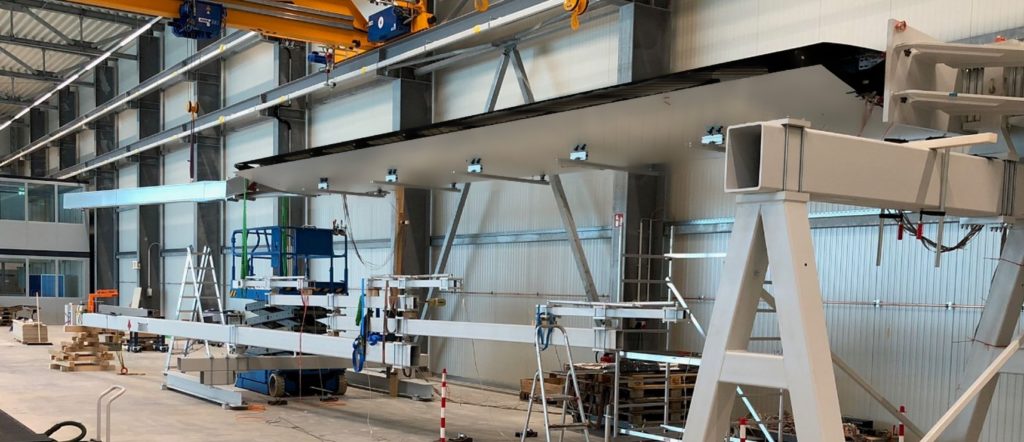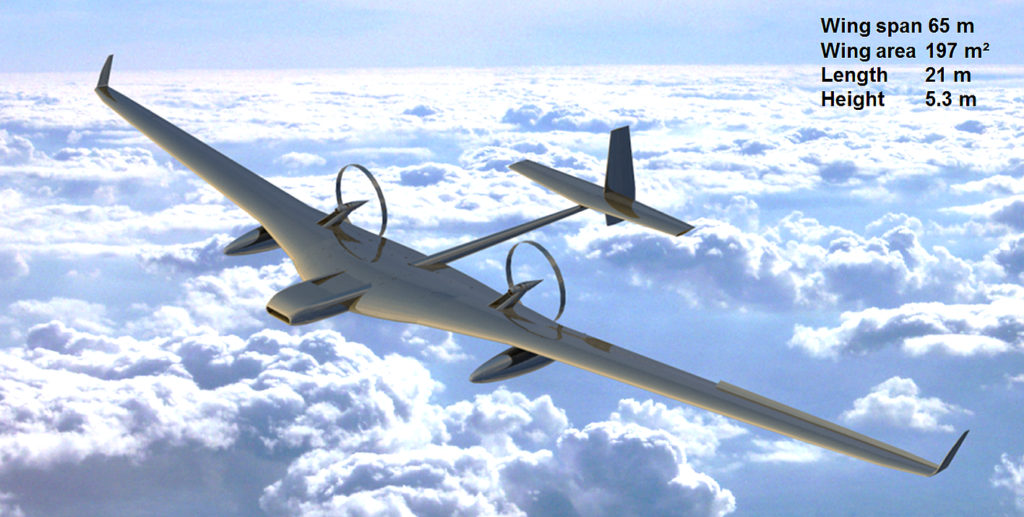Based on concrete specifications from the telecommunications industry, Leichtwerk AG at the Braunschweig Research Airport has been developing an unmanned, high-flying platform with a flight duration of several days for operation in civil airspace since 2015. Certification and aviation safety authorities have been involved in the project from the outset.
The payload uses special beamforming techniques in the ”sub 6GHz” range for mobile communications and in the millimeter-wave range for ground station connectivity and household coverage as an alternative to fixed networks. In this context, up to 100,000 households can be supplied with gigabit speeds per HAPS and nationwide 5G mobile communications can be offered in an area with a diameter of 140 km per HAPS for up to 200,000 phones.
Economics
Depending on its utilization, the StratoStreamer can operate on costs of below USD 10 per month and user. If fully utilized those numbers may go down to below USD 2. In areas with very high demand for capacity per connection the cost is higher but still much lower than for example a ‘Fibre to the Home’ infrastructure or radio towers for area-wide terrestrial mobile radio coverage.
Design
Key features of the aircraft design are:
- Wing span: 65 m
- Wing area: 197 m²
- Payload: 2x 60 kg, diameter up to 3.5 m each, or one antenna with 7 m oval shape
- Certification: EASA Type Certificate
- Operation: Integration into civil airspace
In the overall result, a conventional configuration has prevailed. The payload is integrated into the wing geometry in the area of the wing root. Propulsion and fuel tanks are positioned in pods at about one-third of the half-span, thus relieving the wing but having little effect on flight characteristics. A cooling inlet is integrated in the fuselage tip, with a fuel cell behind it. The wing planform provides for optimized circulation distribution, and the low sweepback utilizes passive load reduction from the resulting bending-torsional coupling. Along the span, the configuration features six wing flaps that act in combination as flaps and ailerons. Segmentation allows optimization of roll rates with reduction of negative turn moment and glide path control.
Flight Dynamics
The permissible speed range allows proper controllability even in gusty conditions. The flight characteristics have been quantitatively derived from experience with the high-performance sailplane ‘eta’. Leichtwerk AG operates the prototype of the ‘eta’ as an instrumented research aircraft and was thus able to validate the coupled aerodynamic and structural design procedures for determining and optimizing the flight mechanical characteristics of the moderately elastic aircraft. This is the basis for the flight dynamic model of the altitude platform and the flight control system.
Structure
The aircraft structure is made entirely of fiber-reinforced plastics. Highly rigid carbon fibers are used in a special prepreg semi-finished product. Fiber quantity and fiber directions are locally optimized throughout the structure in the sense of ‘Taylored Fibre Placement’. On the one hand, all relevant requirements for the airworthiness verification of a fiber composite structure for aircraft according to CS-23, or EASA AMC 20-29, can be met. On the other hand, additional optimization possibilities result from ‘Aeroelastic Tayloring’, i.e. by coupling the bending elasticity with a torsional response of the wing. In the case of upward bending of the wing, this results in a further reduction of the wing incidence angle along the span. All these measures result in a passive load reduction and do not require any active control.
The prepreg semi-finished product used allows the automated production of the aircraft structure with the robots currently used for the production of large aircraft in the industry.
The aircraft structure is verified according to the principle of ‘Substantiation by Analysis supported by Tests’, i.e. the actual strength verification is performed using numerical modeling validated with extensive experiments and strict, project-specific design rules. The complex overall system is developed according to ARP 4754. Requirements from the operation of unmanned aircraft in civil airspace must also be taken into account.
While large sections of the wing are already being manufactured and tested in the area of the aircraft structure, the flight control system is being integrated into a ‘Wooden Bird’ and also subjected to rigorous testing.

Hydrogen Propulsion
For the hydrogen propulsion system, a CFRP tank is being developed for the laminar flow pods to store liquid hydrogen. This must hold the volatile hydrogen at cryogenic temperatures with a low leakage rate and feature vacuum insulation. Initial tank bodies are already being fabricated and tested. The fuel cell system presents a special challenge. This must operate with a high degree of efficiency under the ambient conditions of the stratosphere. This requires the development of particularly efficient compressor systems.
Demonstrator
The technologies available at Leichtwerk AG and its partners allow the realization of a demonstrator. Specific research needs still arise from the work in various specialist areas. This is being implemented in an extensive network of universities, research institutes and industrial partners, and also with the help of the national aeronautics research program. Together with Leichtwerk Research GmbH, topics are being worked on for weather-based flight guidance, icing conditions for slow-flying aircraft, special liner techniques for the hydrogen tank, load collectives for operation in the stratosphere, and procedures for efficiently demonstrating the safety of complex aircraft systems.
Consistent validation of the development work through tests in the context of certification requirements generates a reliable design basis and reduces the risk on the way to the demonstrator.
